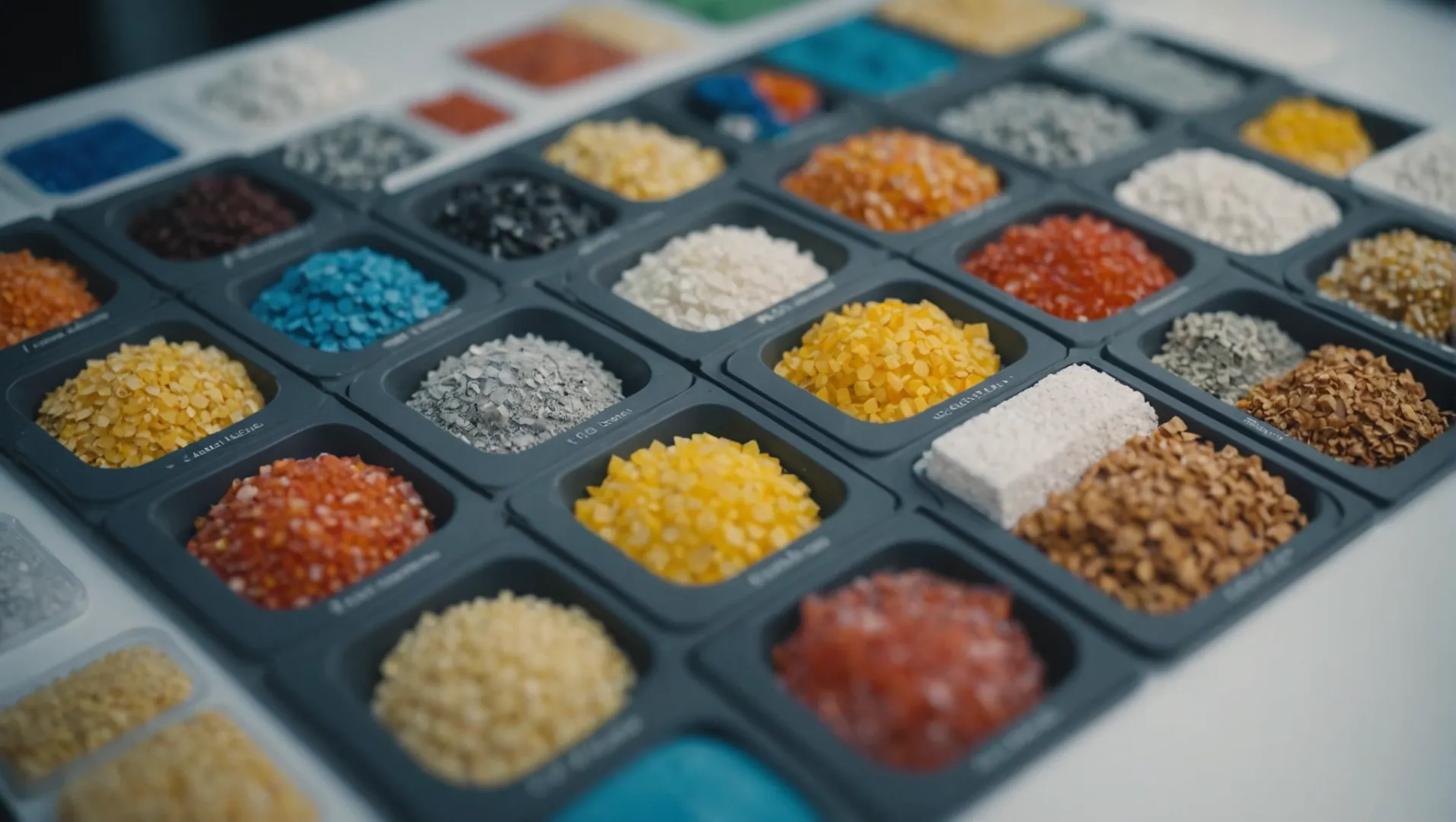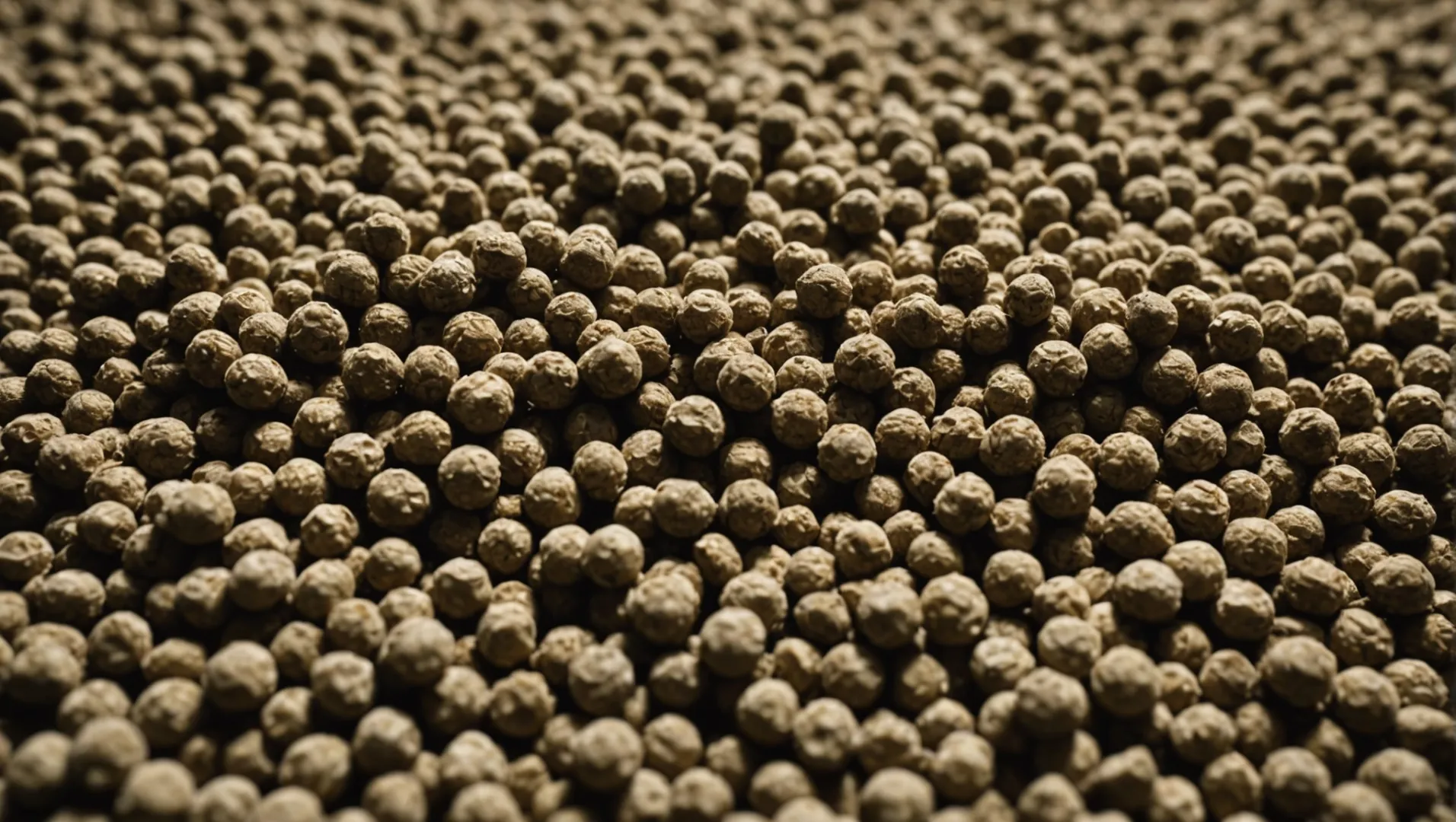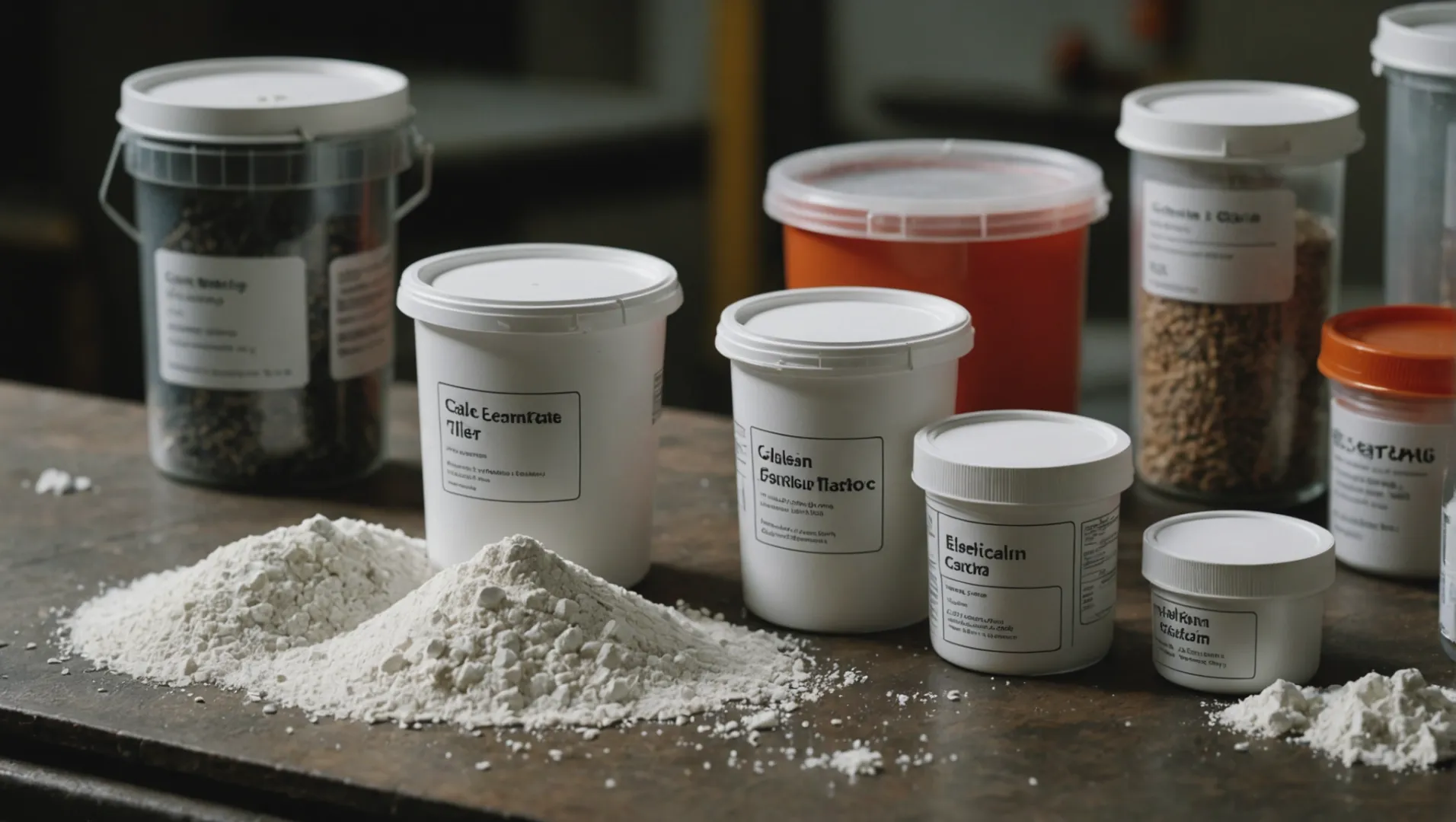
When I first ventured into the world of plastic injection molding, I was surprised to discover how pivotal fillers are to the process. They’re not just there to bulk up the material; they actually shape the very essence of what we’re producing!
Fillers play a crucial role in enhancing the properties of molded plastics. Common fillers include inorganic options like calcium carbonate and talc, alongside organic choices such as wood powder and starch, each offering unique benefits.
Curious about how these fillers work their magic? Let’s dive deeper into their specific characteristics and applications to see how they can transform your next project.
Calcium carbonate reduces costs in plastic injection molding.True
Calcium carbonate is cost-effective, enhancing rigidity and stability.
How Do Fillers Affect the Properties of Plastic Molds?
Fillers are integral to modifying plastic properties, influencing everything from strength to cost. Their impact varies widely based on the type of filler used.
Fillers enhance the mechanical, thermal, and aesthetic properties of plastic molds by altering their rigidity, strength, and stability. Inorganic fillers like calcium carbonate improve hardness and reduce costs, while organic fillers such as wood powder offer eco-friendly benefits.

The Role of Inorganic Fillers
Inorganic fillers like calcium carbonate1 and talc are often employed to enhance the rigidity and thermal stability of plastic molds. Calcium carbonate, for instance, is favored for its ability to improve dimensional stability and hardness while being cost-effective. It finds extensive use in polyethylene and polypropylene molding due to its versatility.
Talc, with its unique layered structure, is another crucial inorganic filler. It not only boosts rigidity but also enhances heat resistance and creep resistance. These properties make it a popular choice in engineering plastics like nylon and polyester.
| Filler Type | Key Features | Common Applications |
|---|---|---|
| Calcium Carbonate | Enhances hardness and reduces costs | Polyethylene, Polypropylene |
| Talc | Improves rigidity and thermal stability | Nylon, Polyester |
The Impact of Organic Fillers
Organic fillers such as wood powder and starch bring unique properties to the table. Wood powder is valued for imparting a natural appearance to plastic products while reducing overall material costs. However, its strong water absorption necessitates surface treatment for compatibility with plastics.
Starch stands out for its biodegradable nature, aligning with the growing demand for sustainable materials. It contributes to reducing the environmental footprint of plastics but requires careful compounding with other materials to offset its poor thermal stability.
| Filler Type | Key Features | Common Applications |
|---|---|---|
| Wood Powder | Provides natural appearance, reduces costs | Wood-plastic composites |
| Starch | Biodegradable, environmentally friendly | Biodegradable plastics |
Fiber Fillers: Enhancing Strength
Glass fiber and carbon fiber are pivotal in enhancing the mechanical properties of plastics. Glass fiber adds strength and heat resistance but may roughen the surface of plastic products, requiring post-treatment. Its application is widespread in reinforced plastics.
Carbon fiber offers exceptional strength and conductivity but comes at a higher cost. It is often reserved for high-performance engineering plastics where these attributes are essential.
Understanding the various fillers’ attributes allows manufacturers to tailor plastic molds precisely to their desired specifications, ensuring optimal performance and cost-effectiveness.
Calcium carbonate reduces the cost of plastic molds.True
Calcium carbonate is cost-effective, making it popular in polyethylene and polypropylene.
Starch fillers improve thermal stability of plastics.False
Starch fillers have poor thermal stability, requiring careful compounding with other materials.
What Are the Environmental Impacts of Using Organic Fillers?
Organic fillers in plastics offer sustainable solutions, but what are their true environmental impacts? Delve into their eco-friendly benefits and potential drawbacks.
Organic fillers like wood powder and starch are renewable and biodegradable, reducing reliance on petrochemical-based materials. They lower carbon footprints and enhance the environmental profile of plastics, but challenges like water absorption and thermal instability need addressing for widespread adoption.

The Eco-Friendly Nature of Organic Fillers
Organic fillers such as wood powder and starch bring a sustainable edge2 to plastic production. Derived from renewable resources, these fillers help lower the environmental impact by reducing dependency on fossil fuels. For instance, wood powder not only adds a natural aesthetic to plastic products but also contributes to a circular economy by utilizing waste wood materials. Starch, known for its biodegradability, makes plastics more environmentally friendly by facilitating their decomposition.
Challenges in Using Organic Fillers
While the benefits are clear, there are challenges associated with using organic fillers in plastics. Wood powder exhibits high water absorption which can affect the mechanical properties of the finished product. This requires additional surface treatments to improve compatibility with the plastic matrix. Similarly, starch’s thermal instability necessitates its combination with other materials to maintain product integrity under heat.
Comparative Analysis: Inorganic vs. Organic Fillers
| Feature/Property | Inorganic Fillers | Organic Fillers |
|---|---|---|
| Source | Non-renewable | Renewable |
| Environmental Impact | Higher carbon footprint | Lower carbon footprint |
| Biodegradability | Non-biodegradable | Biodegradable |
| Thermal Stability | Generally stable | Needs enhancement |
| Water Absorption | Low | High |
The Role of Organic Fillers in Reducing Carbon Footprint
Organic fillers play a significant role in reducing the carbon footprint of plastic products. By substituting a portion of synthetic polymers with natural materials, manufacturers can reduce greenhouse gas emissions associated with traditional plastic production processes. This shift not only aligns with global sustainability goals but also meets growing consumer demand for eco-friendly products.
Exploring advancements in biodegradable composites3 could further enhance the adoption of organic fillers in diverse applications, paving the way for more sustainable manufacturing practices.
Organic fillers reduce the carbon footprint of plastics.True
Organic fillers use renewable resources, decreasing reliance on fossil fuels.
Starch in plastics improves thermal stability.False
Starch is thermally unstable, needing combinations with other materials.
How to Choose the Right Filler for Your Injection Molding Project?
Selecting the appropriate filler for injection molding is crucial to enhance product quality and optimize costs. Here’s how to make the right choice.
To choose the right filler for your injection molding project, consider factors such as the desired mechanical properties, processing conditions, cost constraints, and environmental impact. Evaluate the characteristics of both inorganic fillers like calcium carbonate and organic fillers such as wood powder to align with your project needs.

Evaluating Mechanical Properties
When choosing a filler, it’s important to first assess the mechanical properties you want to enhance in your plastic product. Inorganic fillers like calcium carbonate are widely used due to their ability to improve hardness and rigidity, making them ideal for polyethylene and polypropylene applications. Alternatively, talc can boost rigidity and heat resistance, essential for engineering plastics such as nylon and polyester.
Organic fillers like wood powder can offer a natural appearance while reducing costs, but they may require surface treatments due to their water absorption properties. On the other hand, starch is biodegradable and enhances processability but needs compounding for improved thermal stability.
Processing Conditions and Compatibility
Understanding your processing conditions is critical when selecting fillers. For instance, wollastonite’s needle-like structure can increase strength and dimensional stability in high-performance plastics like polycarbonate. Its low oil absorption also aids in maintaining system viscosity. Conversely, glass fiber4 excels in improving tensile strength but might roughen surface finishes, necessitating post-treatment processes.
Cost Considerations
The economic aspect cannot be overlooked. Fillers like calcium carbonate are cost-effective, widely available, and can significantly reduce production expenses without compromising on quality. While carbon fiber offers exceptional strength and thermal conductivity, its high cost might limit its use to high-performance applications.
Here’s a quick comparison:
| Filler Type | Key Benefits | Cost Implications |
|---|---|---|
| Calcium Carbonate | Improves rigidity, low cost | Economical choice |
| Talc | Enhances heat resistance | Moderate cost |
| Glass Fiber | Increases tensile strength | Higher cost |
| Wood Powder | Eco-friendly, reduces costs | Low cost with treatment costs |
Environmental Impact
Considering the environmental footprint of your project is increasingly important. Organic fillers like starch and wood powder offer eco-friendly alternatives that are biodegradable or sourced from renewable resources. These options can align with sustainability goals, although they may require additional processing adjustments to match the properties of traditional plastics.
Ultimately, a balanced assessment5 of these factors—mechanical enhancement, processing compatibility, cost efficiency, and environmental considerations—will guide you in selecting the most suitable filler for your injection molding project.
Calcium carbonate is the most expensive filler.False
Calcium carbonate is cost-effective, making it an economical choice.
Glass fiber improves tensile strength in plastics.True
Glass fiber enhances tensile strength but may roughen surface finishes.
What Are the Cost Implications of Different Fillers?
Exploring the cost implications of fillers can guide manufacturers in optimizing both quality and expenses in plastic injection molding.
The cost implications of fillers in injection molding depend on their type, availability, and the specific application they are used for. Inorganic fillers like calcium carbonate are generally cheaper, while high-performance fillers such as carbon fiber are more costly due to their superior properties.

Understanding the Price Spectrum of Fillers
Fillers in plastic injection molding vary widely in cost, primarily due to their distinct properties and applications. Calcium carbonate is one of the most cost-effective inorganic fillers. It is abundant and can significantly reduce the overall material cost while enhancing the rigidity and stability of plastics. Its low price makes it a popular choice for manufacturers aiming to balance performance with budget constraints.
In contrast, talc, although slightly more expensive than calcium carbonate, offers additional benefits such as improved heat resistance and surface finish. This makes it suitable for applications where these characteristics are paramount.
At the higher end of the price spectrum are fillers like carbon fiber and glass fiber. These materials come with a heftier price tag due to their exceptional strength and durability. For projects requiring high-performance plastics, the investment in these fillers can be justified by the substantial improvements in mechanical properties.
| Filler Type | Cost Range | Typical Applications |
|---|---|---|
| Calcium Carbonate | Low | Polyethylene, polypropylene |
| Talc | Moderate | Engineering plastics like nylon |
| Mica Powder | Moderate | Electronics, automotive sectors |
| Wollastonite | Moderate | High-performance plastics such as polycarbonate |
| Glass Fiber | High | Reinforced plastics for various engineering uses |
| Carbon Fiber | Very High | High-performance engineering plastic products |
Balancing Cost with Performance
When choosing fillers, manufacturers must evaluate not only the cost but also the performance benefits they bring to the final product. For instance, using calcium carbonate6 can result in substantial cost savings; however, it may not provide the necessary enhancements for all types of applications.
On the other hand, investing in high-cost fillers like carbon fiber7 can elevate the product’s mechanical properties and longevity, making them ideal for specialized industries that demand exceptional performance.
Decision-Making Factors
The selection of an appropriate filler hinges on several factors:
- Performance Requirements: Determine the mechanical and aesthetic needs of the final product.
- Budget Constraints: Evaluate how much you are willing to spend on materials relative to the benefits gained.
- Material Availability: Consider how readily available each type of filler is in your region.
- Environmental Impact: Assess whether organic options like wood powder8 or starch9 could serve as sustainable alternatives.
By understanding these variables, manufacturers can make informed decisions that optimize both cost and product performance.
Calcium carbonate is the cheapest filler in injection molding.True
Calcium carbonate is abundant and cost-effective, reducing material costs.
Carbon fiber fillers are more affordable than glass fiber fillers.False
Carbon fiber is more expensive due to its superior strength and durability.
Conclusion
Choosing the right filler is essential for optimizing performance and sustainability in plastic products. With a solid understanding of each filler’s unique benefits, I feel empowered to enhance product quality and reduce costs.
-
Discover how calcium carbonate enhances plastic properties effectively.: Plastic filler from Calcium carbonate is an additive used to increase the elasticity, viscosity and heat resistance of plastics. ↩
-
Discover how organic fillers contribute to sustainability in plastics.: The versatility of these materials means they can be adapted to different uses, improving product sustainability without compromising quality. ↩
-
Learn about cutting-edge developments in biodegradable composites.: Biodegradable polymers are being developed to be used as an alternative for non-biodegradable polymer materials in a variety of applications4. ↩
-
Learn how glass fiber enhances plastic’s mechanical properties effectively.: Glass fibers combine the properties of glass with those of plastics. This makes injection molding possible. But the injection molding of glass … ↩
-
Discover strategies for balancing performance with budget constraints.: Explore key strategies for cost reduction in injection moulding, including design optimization, material selection, and efficient practices. ↩
-
Calcium carbonate is widely used for its low cost in molding.: Source the carbonate you need. Check out calcium carbonate for injection molding and every other variety of carbonate products at Alibaba’s wholesale store. ↩
-
Carbon fiber offers unmatched strength and durability.: Most bikes are shipped partly built, but they require assembly at the store. So part of the cost is associated with building the bike, but also, … ↩
-
Wood powder offers a natural look and reduces costs.: Wood powder: Wood powder is one of the most common fillers, made by grinding wood into fine particles. It can enhance various properties of … ↩
-
Starch is biodegradable and environmentally friendly.: Another feature of plasticizers is their hydrophilicity, which allows starch bioplastics to biodegrade faster than with sorbitol. Therefore, depending on the … ↩






